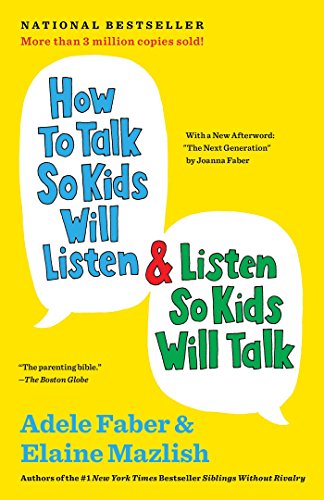
Anytime I indulge myself with lots of light fiction, I gravitate toward some thoughtful nonfiction to help balance out my reading life. This month is no exception, and after finishing a few trilogies, I’ve been diving into How to Talk so Kids Will Listen & How to Listen So Kids Will Talk by Adele Faber and Elaine Mazlish.
This dense, 350-page book is packed full of wisdom aimed at parents, but I’m taking away lots of lessons as a teacher.
Two questions the authors pose in their chapter on praise have stayed with me:
- What is the relationship between how children think of themselves and their willingness to accept challenges or risk failure?
- What is the relationship between how children think of themselves and the kinds of goals they set for themselves?
As a literacy teacher, I connect students’ willingness to take risks, challenge themselves, and set worthwhile goals with their ability to grow as readers and writers. Students who have autonomy will often engage with the reading and writing we do in our classroom, but without an intrinsic desire to grow, they may stagnate.
Faber and Mazlish’s response to this is connected to the kind of praise we offer children, which helps define their self-concepts. The authors give us a simple directive: when children come to adults with something to which they desire a response, don’t evaluate; describe what you see or feel–then students will praise themselves.
This feels highly applicable to conferring moments that we have with students. I can attest to its effectiveness; after reading Peter Johnston’s work, I shifted the way I responded to students away from fixed to dynamic praise–focused on growth. I made a second shift when I noticed that the reading conferences I had with students about books I had not read were more fruitful than ones where I wanted to gush about the book–both habits helped me, essentially, to talk less, and listen more.
But the precision of our language is important. “From our small descriptions our children learn what their strengths are,” write Faber and Mazlish. We must be thoughtful and careful with how we speak to our students. “It’s a lot easier to say ‘Wonderful’ about something, than to really look at it, and experience it, and then describe it in detail,” they continue (182). This feels highly pertinent when we think about responding to student work.
My takeaway from this book–a book I recommend for all teachers who want to thoughtfully evaluate their own habits of language–is that the less we speak, the more kids will talk. The more precise and helpful our talk is, the more kids will listen. That will lead them, circuitously, back to the two questions I am still thinking about–how we can get kids to take risks and challenge themselves with their goal-setting. The answer, for me, is building their self-esteem as readers and writers, so they’ll take it upon themselves to grow.
This work isn’t easy. It is slow, thoughtful, deep work–but that’s what makes teaching so wonderful. As we finish out this wintry week, may we internalize this lesson: the heart of our jobs as teachers is to talk so kids will listen and listen so kids will talk. Enjoy every word.
Shana Karnes fills her days working with teachers, students, and her own small children in Madison, Wisconsin. She enjoys talking with all three groups about reading, writing, and learning. Connect with Shana on Twitter at @litreader.

What are you thinking?